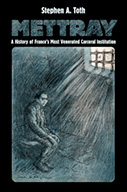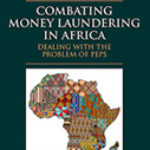Mettray: A History Of France’s Most Venerated Carceral Institution

Author: Stephen A. Toth
Publisher: Ithaca, NY: Cornell University Press, 2019. 280p.
Reviewer: Colin Ripley | May 2021
A couple of months ago, when my review copy of Stephen A. Toth’s new book Mettray: A History of France’s Most Venerated Carceral Institution arrived at my home office, the first thing Idid (as a good and somewhat self-interested scholar) was to open the book to the index. A bit tomy surprise (albeit a pleasant one), I found my name listed along with two references; clearly Dr.Toth had done his research, and had found my obscure paper about Mettray from about fifteen years ago. My pleasure turned to a bit of bemusement, however, when I checked out the first of the references and found myself referred to, probably for the first time in my life, as ageographer (I am in fact an architect).
I start with this anecdote not in order to put myself at the center of the discussion, or to be petty, but because this episode became emblematic for me of a bit of a pattern as I read through the book: a conjunction of deep (and important) research coupled with a few minor misfires, a certain sloppiness in the delivery. In what follows I will try to clarify what I mean.
The Colonie Agricole Pénitentiaire de Mettray was an experimental institution for housing and reforming delinquent children, located just outside of Tours, France. The Colony, founded by jurist and penal reformer Frédéric-Auguste Demetz, who acted as its Director for several decades, and designed by noted prison architect Guillaume-Abel Blouet, was opened in 1840 and maintained operations for almost a century, closing in 1937. Although not well known in the English-speaking world, Mettray was an important and influential institution internationally in the nineteenth century,and remains a critical episode in several different areas of study: in studies in the history of justice,especially of juvenile justice; in cultural history and philosophy, due to the Colony’s presence in the work of Michel Foucault; and in both modern literature and queer studies due to the work of arguably the most famous of colonists, Jean Genet, who wrote several semi-fictional accounts of his time at Mettray. However, the history of this important institution has not, until now, been easily accessible; this is, as far as I know, the first monograph dedicated to tracing that history. Stephen Toth certainly “has the chops” to pull off this task, as an Associate Professor of Modern European history at Arizona State University, whose previous book had been about the better-known subject of the French overseas penal colonies. Dr. Toth has been able to put together this book because of access to the Mettray archives, which have only recently been moved from an outbuilding on the Mettray site, catalogued, and made available to researchers at the Departmental Archives in Tours.As a result, this book is very welcome and, if anything, overdue.
Toth’s primary goal in the work, beyond bringing Mettray more to the awareness of an English-speaking audience and establishing the essential historical timeline of Mettray, is to move past what Toth sees as Foucault’s overly conceptual view of the Colony, to demonstrate how, and to what degree, the institution accomplished its disciplinary effects. In addition, by diving more deeply into the existing records, Toth seeks to demonstrate the ways in which colonists provided resistance to these disciplinary techniques, to use, where possible, the words of the colonists themselves, or, where not possible, to make inferences from official documents that might allow him to speak for them. Of particular use in this effort appears to have been a collection of letters, clearly meant to be taken as confidential, in which the administrators of the Colony provided advice and direction to each other. These letters, particularly around questions of visitation rights, provide significant new insight into the ways the Colony’s administration understood the role of the family, and by extension, into developing understandings of masculinity in modern France. Especially strong are the discussions of the daily regime at Mettray (accompanied with very useful tables) as well as the emphasis on a pseudo-military regime and of the development of the body; if anything, the chapter on the regime of the Colony left me looking for even more detail. Chapters on the Maison Paternelle (a separate institution on the grounds of Mettray which housed children of wealthy families confined by order of their fathers) and on the last decades of Mettray (including the discussion of Mettray’s varying fortunes in relation to the political situation in France) are also particularly strong. There is much to be learned here, and I expect to refer back to this work frequently in the coming years.
Surprisingly, however, given the stated goals of the work, the chapter on resistance as offered by the colonists is not as strong. First, the chapter seems strangely organized, starting with a long discussion of homosexuality in the Colony, followed by masturbation, followed by a discussion of tattoos, followed by miscellaneous punishments meted out, and so on. The various topics seem to flow in an almost random order; while these are all important points and indeed important modes of resistance, it would have been useful, I think, to provide some sort of framework to organize the discussion. This might have taken the form of a theoretical discussion of resistance of dominated or subaltern groups. Where Toth does start to refer to such a framework, he makes use of the work of James Scott and Erving Goffman, but without, to my mind, adequate contextualization; the work of these latter authors seems to pop up a bit out of nowhere. A few pages to lay out how their work, developed in very different situations from Mettray, that could help us to understand modes of resistance in the Colony might have been helpful. This might have helped us, as well, to understand Toth’s critique of Foucault, which really appears only as a sketch, in the introduction to the book.
Then too, the vast majority of material put forward in this chapter on resistance came from official records, such as notations made by various officials on the files of colonists. While these are of course not without interest, and indeed are fascinating, it is a bit hard to reconcile these notations with the stated desire to speak in the colonists’ words. We are seeing the colonists, and their acts of resistance, through the eyes and the official words (written for official purposes) of their oppressors. In terms of the colonists’ own words, Toth relies on essentially two sources: Jean-Guy Le Dano and Jean Genet, both of whom were at Mettray during the same rough time period (between the two World Wars — that is, near the end of Mettray’s existence) and both of whom were writing works of ostensible fiction (interestingly, the bibliography here lists Le Dano’s novel as a secondary source, while Genet’s is a primary source). Toth, unfortunately, does little to situate these sources for us. Le Dano, for example, is simply “the former convict” (p. 91), without reference to his later life or the circumstances under which he wrote his description of Mettray. Furthermore, we are left without sources from the earlier more generally positive period of Mettray’s existence. Toth does not trace for us the ways in which resistance may have evolved over the decades. Although the author is generally clear as to where his sources lie, he tends to question neither the veracity nor the motives of his sources, leading his readers to take their statements as simple truth. Toth does not point out, for example, that Le Dano’s statement about the walls of the toilets at Mettray, a statement made many years after the closure of the Colony, was itself an act of resistance to the Colony’s regime.
Toth’s bibliography also has a few issues, one of which is the odd distinction between primary and secondary sources mentioned above. More puzzling though are a couple of glaringly missing sources, such as Luc Forlivesi, Georges-François Pottier and Sophie Chassat’s 2005 edited volume Eduquer et punir: la colonie agricole et pénitentiaire de Mettray (1839-1937), and Jean Genet’s unpublished screenplay Le Langage de la Muraille. These are troubling gaps, especially since, on the one hand, Pottier was Director of the archive in which Toth did his research at Tours, and on the other hand Genet’s screenplay (of which I understand there is a copy in the Tours archives) was written explicitly in response to Foucault’s account of Mettray — that is, explicitly in support of Toth’s stated thesis for this work.
In the end though, these issues and complaints are quibbles, and I don’t want them to take away from an account of what I think is an important, well-researched, well-written and deeply readable work that will bring this important site to the attention of many more historians and cultural thinkers. Bravo!
Colin Ripley, Ryerson University Department of Architectural Science


